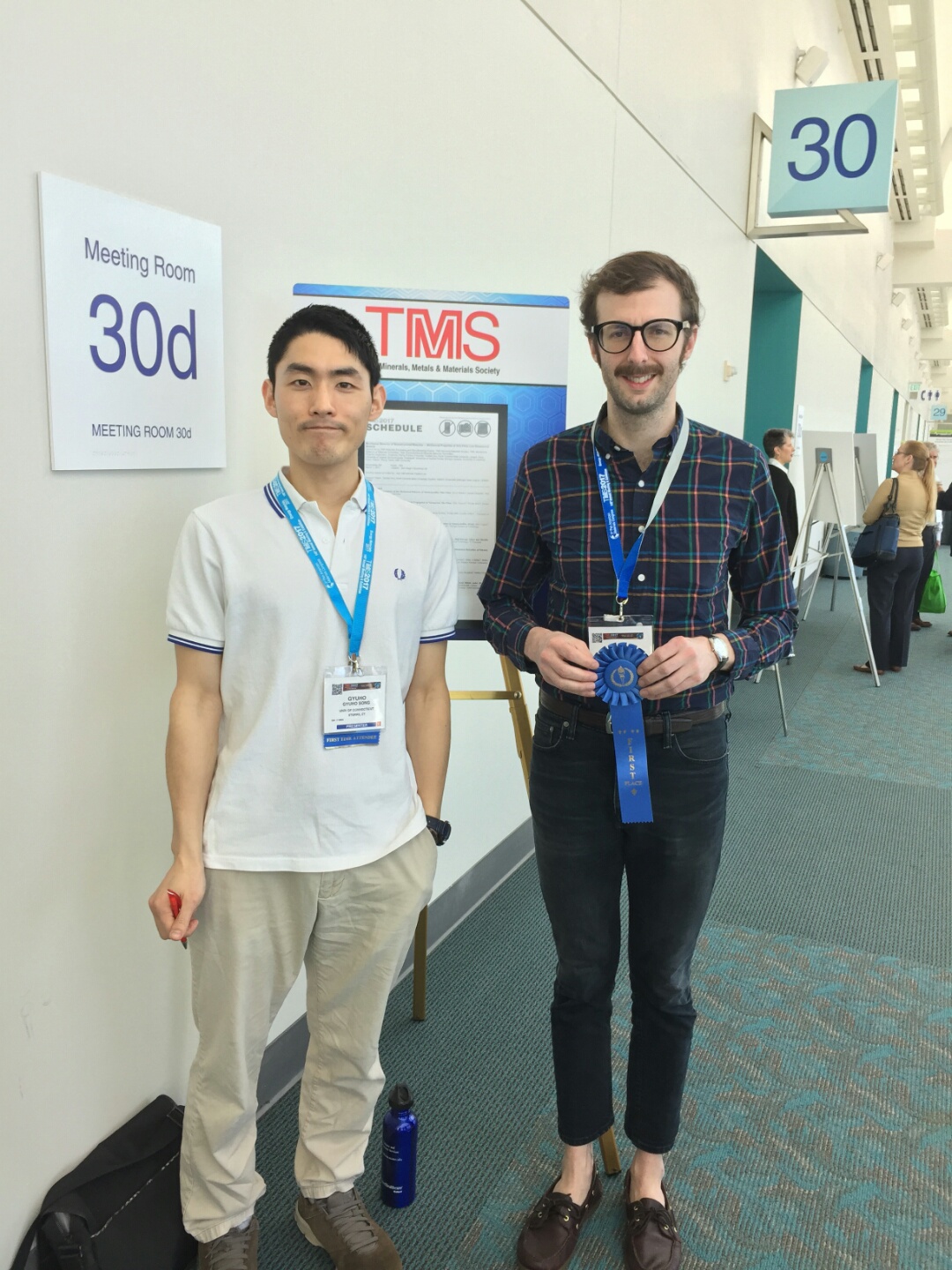MSE Graduate Students Awarded at TMS 2017
By Amanda Campanaro

Graduate students Gyuho Song (Left) and Keith Dusoe, of Seok-Woo Lee’s lab, who won silver and gold for their posters, respectively.
Graduate students from the Department of Materials Science and Engineering were awarded gold and silver medals at the TMS (the Minerals, Metals and Materials Society) 2017 meeting in San Diego, CA. The awards were announced during the poster session of the Mechanical Behavior of Nanostructured Materials Session, and included Keith Dusoe and Gyuho Song, both of MSE Assistant Professor Seok-Woo Lee’s lab.
Third-year Ph.D. student Keith Last name was awarded gold for his poster entitled “Strong, Ductile, Thermally Stable Cu-based Metal-intermetallic Nanostructured Alloys,” (Figure 1). This study was carried out in collaboration with Dr. Mark Aindow and his group who helped Keith and Dr. Seok-Woo Lee with the microstructural characterization of this interesting intermetallic alloy.
Keith’s research was also published in Scientific Reports earlier this year. There were significant contributions from undergraduate MSE majors Thomas Bissell, Jack Morley and Leopoldo Valencia Jr., who co-authored with Keith and Drs. Mark Aindow and Avinash Dongare.
Gyuho Song, a first-year Ph.D., was awarded silver for his poster titled “Synthesis of Bulk Single-crystalline Quasicrystal Approximant YCd6 and Its Small-scale Mechanical Properties,” (Figure 2) in collaboration with Dr. Seok-Woo Lee at UConn and graduate student Tai Kong and Distinguished Professor of Physics and Astronomy Paul Canfield, both of Iowa State University.

Figure 1. Research for Keith Dusoe’s poster which was awarded gold: (a) The microstructure of Cu85Zr10Ti5 alloys; (b) TEM image of Cu phase; (c) TEM image of Cu5Zr superlattice phase; (d) Stress-strain curves of Cu-Zr-Ti systems, which exhibit high strength and high ductility; (e) TEM image of as-cast specimen; (f) TEM image of annealed specimen (500oC for 24 hours). This result shows a superior thermal stability of microstructure. Typically, the grain size of conventional alloys becomes four times larger at the same thermal condition, but our material shows the negligible change in grain size. (Reference: Keith J. Dusoe, Sriram Vijayan, Thomas R. Bissell, Jie Chen, Jack E. Morley, Leopoldo Valencia, Avinash M. Dongare, Mark Aindow & Seok-Woo Lee, “Strong, ductile and thermally stable Cu-based metal-intermetallic nanocomposites,” Scientific Reports, 7, 40409 (2017))
![Figure 2. Research conducted for Gyuho Song’s poster entitled “Synthesis of Bulk Single-crystalline Quasicrystal Approximant YCd6 and Its Small-scale Mechanical Properties:” (a) Solution-grown single crystal YCd6 quasicrystal approximant; (b) Active four slip planes under [0 0 1] compression; (c) Large interplanar spacing of {0 1 1} layers; (d) four possible {0 1 1} slip planes for [0 0 1] loading, which is consistent with micropillar compression results in (b). Regardless of highly complex atomic configuration (a body-centered cubic crystal structure with the Tsai-type icosahedral cluster consisting of Cd and Y shells), its translational symmetry allows plastic slip events. Note that quasi-periodic arrangement of the same icosahedral cluster in YCd7.48 quasicrystal causes the extreme brittleness (not shown here).](https://mse.engr.uconn.edu/wp-content/uploads/2017/03/figure2.jpg)
Figure 2. Research conducted for Gyuho Song’s poster entitled “Synthesis of Bulk Single-crystalline Quasicrystal Approximant YCd6 and Its Small-scale Mechanical Properties:” (a) Solution-grown single crystal YCd6 quasicrystal approximant; (b) Active four slip planes under [0 0 1] compression; (c) Large interplanar spacing of {0 1 1} layers; (d) four possible {0 1 1} slip planes for [0 0 1] loading, which is consistent with micropillar compression results in (b). Regardless of highly complex atomic configuration (a body-centered cubic crystal structure with the Tsai-type icosahedral cluster consisting of Cd and Y shells), its translational symmetry allows plastic slip events. Note that quasi-periodic arrangement of the same icosahedral cluster in YCd7.48 quasicrystal causes the extreme brittleness (not shown here).
Published: March 3, 2017
Categories: awards, conferences, news, undergraduate students
Available Archives